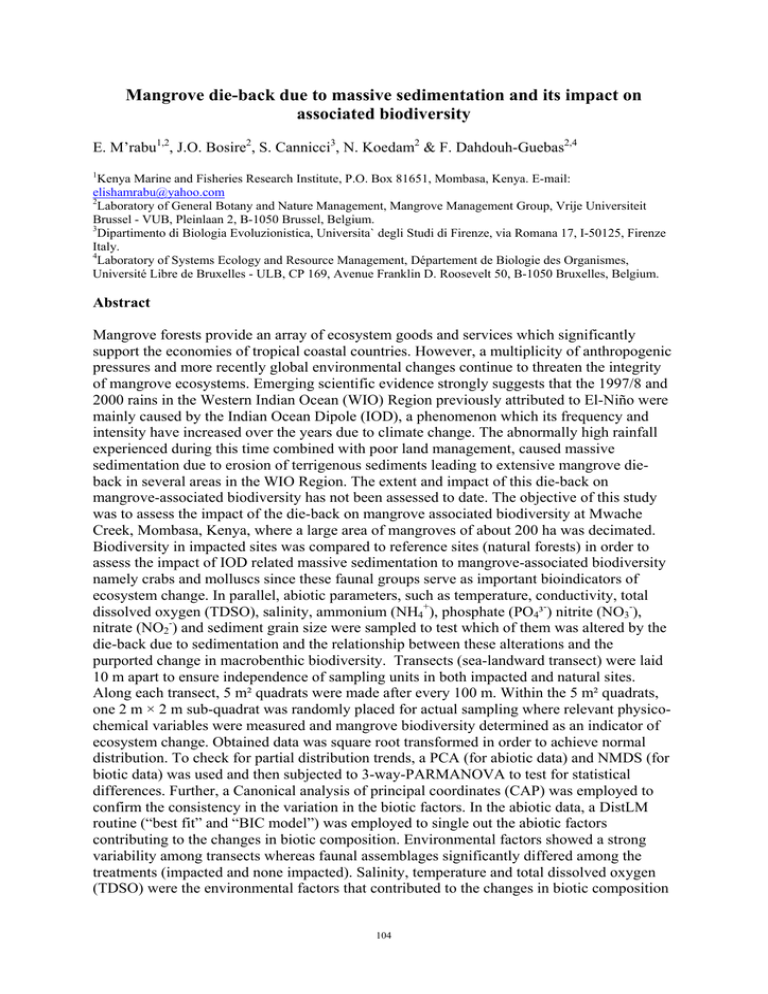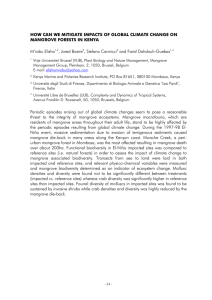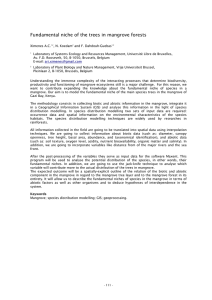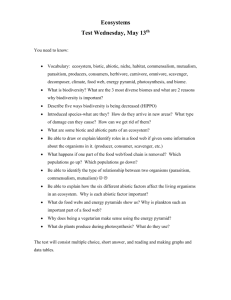Mangrove die-back due to massive sedimentation and its impact on
advertisement

Mangrove die-back due to massive sedimentation and its impact on associated biodiversity E. M’rabu1,2, J.O. Bosire2, S. Cannicci3, N. Koedam2 & F. Dahdouh-Guebas2,4 1 Kenya Marine and Fisheries Research Institute, P.O. Box 81651, Mombasa, Kenya. E-mail: elishamrabu@yahoo.com 2 Laboratory of General Botany and Nature Management, Mangrove Management Group, Vrije Universiteit Brussel - VUB, Pleinlaan 2, B-1050 Brussel, Belgium. 3 Dipartimento di Biologia Evoluzionistica, Universita` degli Studi di Firenze, via Romana 17, I-50125, Firenze Italy. 4 Laboratory of Systems Ecology and Resource Management, Département de Biologie des Organismes, Université Libre de Bruxelles - ULB, CP 169, Avenue Franklin D. Roosevelt 50, B-1050 Bruxelles, Belgium. Abstract Mangrove forests provide an array of ecosystem goods and services which significantly support the economies of tropical coastal countries. However, a multiplicity of anthropogenic pressures and more recently global environmental changes continue to threaten the integrity of mangrove ecosystems. Emerging scientific evidence strongly suggests that the 1997/8 and 2000 rains in the Western Indian Ocean (WIO) Region previously attributed to El-Niño were mainly caused by the Indian Ocean Dipole (IOD), a phenomenon which its frequency and intensity have increased over the years due to climate change. The abnormally high rainfall experienced during this time combined with poor land management, caused massive sedimentation due to erosion of terrigenous sediments leading to extensive mangrove dieback in several areas in the WIO Region. The extent and impact of this die-back on mangrove-associated biodiversity has not been assessed to date. The objective of this study was to assess the impact of the die-back on mangrove associated biodiversity at Mwache Creek, Mombasa, Kenya, where a large area of mangroves of about 200 ha was decimated. Biodiversity in impacted sites was compared to reference sites (natural forests) in order to assess the impact of IOD related massive sedimentation to mangrove-associated biodiversity namely crabs and molluscs since these faunal groups serve as important bioindicators of ecosystem change. In parallel, abiotic parameters, such as temperature, conductivity, total dissolved oxygen (TDSO), salinity, ammonium (NH4+), phosphate (PO4³-) nitrite (NO3-), nitrate (NO2-) and sediment grain size were sampled to test which of them was altered by the die-back due to sedimentation and the relationship between these alterations and the purported change in macrobenthic biodiversity. Transects (sea-landward transect) were laid 10 m apart to ensure independence of sampling units in both impacted and natural sites. Along each transect, 5 m² quadrats were made after every 100 m. Within the 5 m² quadrats, one 2 m × 2 m sub-quadrat was randomly placed for actual sampling where relevant physicochemical variables were measured and mangrove biodiversity determined as an indicator of ecosystem change. Obtained data was square root transformed in order to achieve normal distribution. To check for partial distribution trends, a PCA (for abiotic data) and NMDS (for biotic data) was used and then subjected to 3-way-PARMANOVA to test for statistical differences. Further, a Canonical analysis of principal coordinates (CAP) was employed to confirm the consistency in the variation in the biotic factors. In the abiotic data, a DistLM routine (“best fit” and “BIC model”) was employed to single out the abiotic factors contributing to the changes in biotic composition. Environmental factors showed a strong variability among transects whereas faunal assemblages significantly differed among the treatments (impacted and none impacted). Salinity, temperature and total dissolved oxygen (TDSO) were the environmental factors that contributed to the changes in biotic composition 104 among the treatments whereas Uca inversa, U. annulipes, Cerithidea decollata and Perisesarma guttatum contributed more to the differences in faunal composition between treatments. The degradation seems to have significantly reduced crab and mollusc species richness and densities and led to loss of other mangrove associated faunal species in the impacted site. Keywords anthropogenic pressure, global environmental change, El-Niño, mangrove die-back, WIO, bioindicator species, sedimentation, ecosystem change 105




